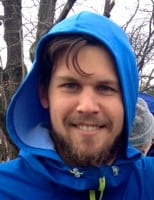Warm temperatures, sharp turns, and tile surfaces couldn’t slow down Tony Migliozzi at the IAU 50k World Championships in Doha, Qatar, which was held on December 4th. Despite the unfavorable conditions, and the monotonous task of running the same 5k loop a full 10 times, the 26-year-old ran away from the field after 40k and broke the tape first in 2:52:08—the sixth-fastest 50k time by a North American. In his first time racing beyond the marathon distance—a distance he has covered in as fast as 2:17:27—Migliozzi also helped the U.S. men’s team earn a silver team medal. In the following interview, Migliozzi talks about his collegiate and road-racing background, his 50k training, how the 50k race played out for him, and his racing plans for 2016.
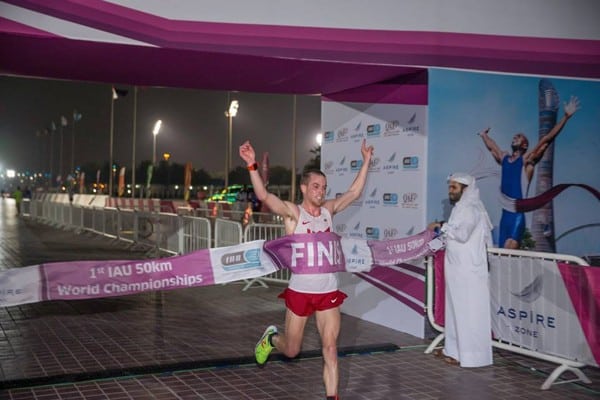
Tony Migliozzi, 2015 IAU 50k World Champion. All photos courtesy of Tony Migliozzi.
iRunFar: Tony, you are now a world champion at the 50k distance. Congratulations! How are you feeling today?
Tony Migliozzi: Thank you! I’m good, I had one of my first runs back today since the [race]. I ran about 12 miles.
iRunFar: Twelve miles for the first run back? That’s not short!
Migliozzi: Well I ran 12 miles yesterday also. So yesterday was the first day back.
iRunFar: You’re right back to it, then. Well let’s hear a little bit about you. You did a short interview with Matt Flaherty after the 50k that I was reading, and it looks like you’re from Ohio—is that right?
Migliozzi: Yep, yeah, I’m from Ohio. I grew up in Louisville, Ohio.
iRunFar: Where is that exactly?
Migliozzi: It’s an hour from Cleveland. It’s near the Pro Football Hall of Fame.
iRunFar: And you went to Saint Thomas Aquinas High School?
Migliozzi: Yeah, that’s right, I graduated in 2008.
iRunFar: How were the track and cross-country teams there?
Migliozzi: When I first—before high school, I didn’t even know that cross country was a sport. But I’m pretty sure our cross-country team was the worst in the state. There’s always this big meet, an invitational, and almost every high school with a cross-country program shows up and I think my high school was second to last that year, my freshman year of high school. They weren’t very good.
I played football my freshman year, I played running back, and cornerback on defense. I ran track my freshman year. I was more of a sprinter, but my coach—Matt Reneker—somehow got me to do a mile and I ended up running a 4:41 my freshman year. That was pretty good, the best on the team. And then [Reneker] convinced me to run cross country that next year, my sophomore year. The rest is history I guess from there—we won two state titles as a team, we were a really close team, and those guys are still some of my best friends.
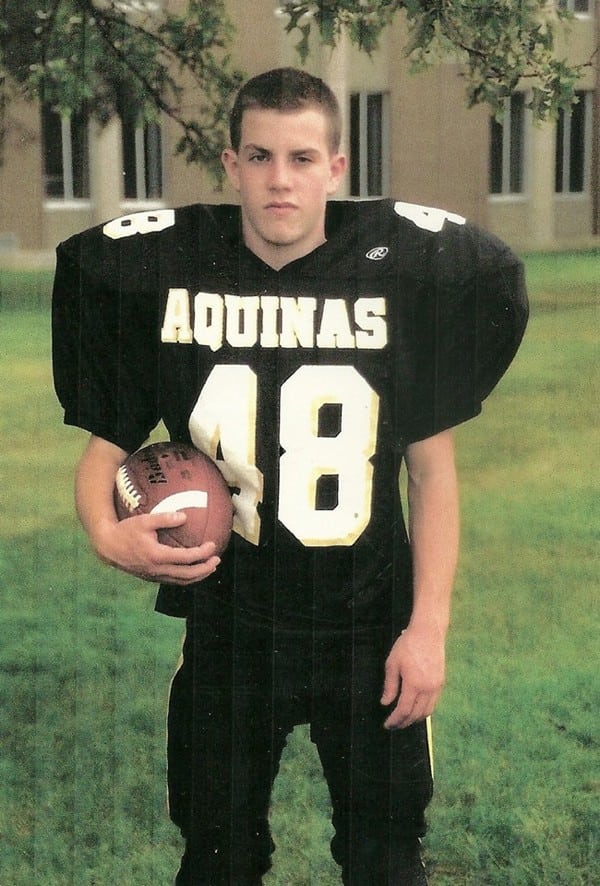
Tony as a freshman playing high-school football.
iRunFar: Awesome. When you started cross country—it sounds, and maybe the road was bumpier than you maybe suggested, but it sounds like you had pretty instant success in track. Was that true for cross country, too?
Migliozzi: Well yeah, my very first cross-country [5k] was 17:08. I think my slowest time that year was somewhere around 17:40. My first race was 17:08, and I had success right away, yeah. As a team, we really gelled; we did workouts well together and pushed each other. But yeah, I had success right away, I guess.
iRunFar: So what was your PR, at the end of high school, in the 5k?
Migliozzi: My best time was 15:47, I believe. Not super fast, but it was a good time, I guess.
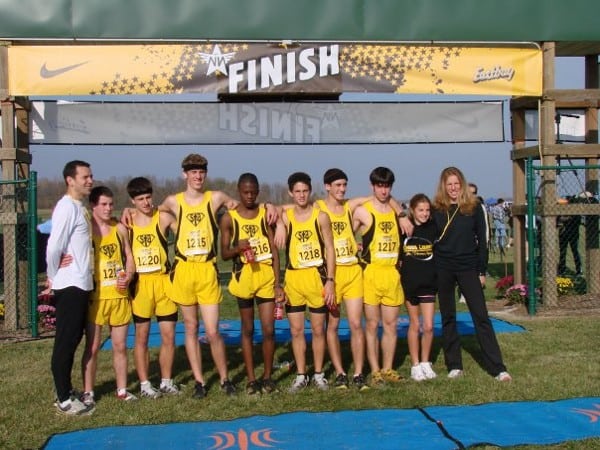
Tony with his high-school team at the Nike Cross-Country Team Nationals.
iRunFar: That landed you running in college—I don’t know if you were on a scholarship or anything—but you were running for a National Association of Intercollegiate Athletics (NAIA) school?
Migliozzi: Yeah, I ran NAIA in college on a pretty small, initial scholarship at Malone University. Freshman year we were national champions in NAIA for cross country—I wasn’t on varsity, though. But I was able to see what it took, so that motivated me to keep improving. The next year we were national champions again and I was on varsity that year.
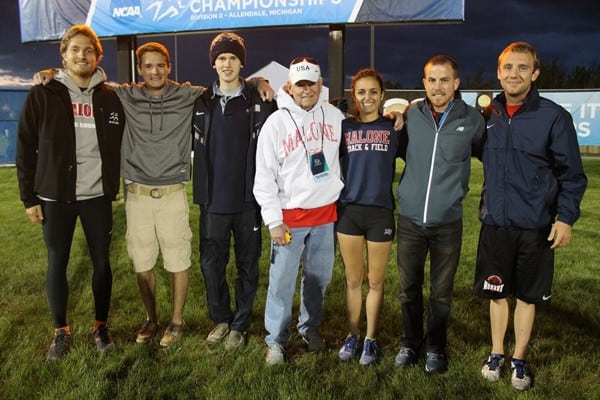
Tony with Malone University and Olympic track-and-field distance coach Jack Hazen and some teammates.
iRunFar: Again, it sounds like your successes kept continuing through college. How did you end up at the end of college—I know that NAIA runners can compete at the marathon distance in college—but what were some of your best times by the end of college?
Migliozzi: Yeah, NAIA, it’s cool that they offer the marathon. I ran the marathon my junior year, which was a little premature, but I didn’t have the option my senior year because we were going to be in a probation period, and not allowed to compete, because we were transferring from NAIA to [National Collegiate Athletic Association] (NCAA) Division II. So I kind of had to do it my junior year. I got second in the nation in the marathon behind a Kenyan—I forget his name. I started out way behind, maybe 13th halfway through, and then finished in second. My track times weren’t really that impressive. I ran 14:33 [in the 5k] and 30:08 [in the 10k]. Those were nice PRs for college.
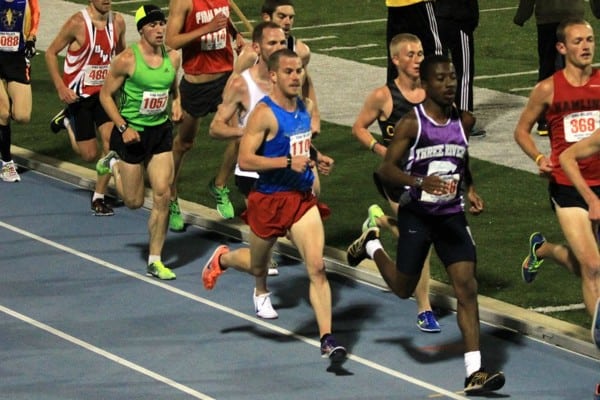
Setting his college 10k PR of 30:08.
iRunFar: Yeah, definitely not slow.
Migliozzi: Yeah [laughs].
iRunFar: Those are very fast times for sure.
Migliozzi: Slightly above average, I guess [laughs].

Tony running the 5k in 14:33 for Malone University.
iRunFar: When I read the interview that you did with Matt Flaherty, which I already mentioned, you said something like, “the more miles, the merrier.” I suppose it was only a matter of time before you found yourself at the start line of a 50k, of an ultra?
Migliozzi: Yeah, I mean I’ve been running high mileage for a long time now. I’ve averaged— including my time off—I’ve averaged over 100 miles per week every year for the last four years. I didn’t expect to run a 50k this early, but when the USA comes knocking on your door, you don’t turn down the offer. I definitely wanted to represent my country and get to the starting line healthy.
iRunFar: I take it that the motivation to choose you for the team was based on some of your road-marathon times. What’s it been like since you graduated college, in terms of your racing career?
Migliozzi: I’ve pretty much been doing road marathons since I graduated. I was getting a little support from Newton, the shoe company, then that kind of fell through a little bit. Then I’ve been receiving support from Second Sole and now New Balance. But yeah, doing as much as my body can handle. Really trying to get in a big marathon in the fall and then see what I can do in the spring, just try to stay in shape.
The Houston Marathon is initially where I qualified for the [U.S. Marathon] Olympic Trials in January. I really didn’t think I was in very good shape for that race. The training leading up to it didn’t go very well. Initially I was supposed to do the half and I switched to the full because I didn’t think I was fast enough [for the half] anymore. It wasn’t very good training at all but I still got to the starting line and still raced it, and it ended up being a phenomenal race.
iRunFar: A 2:17 off not ideal training is a good sign.
Migliozzi: [laughs] Yeah. I had done about six or seven marathons before that.
iRunFar: But that was your first time qualifying for the Trials?
Migliozzi: Yeah, first time qualifying for the Trials, first time under 2:18.
iRunFar: Right. So what was your previous best?
Migliozzi: I usually do the Columbus Marathon—I had done that a few years. But the marathon before that was the USATF [Marathon] Championships in Minnesota, in October.
iRunFar: Was that the Grandma’s Marathon?
Migliozzi: No, it was actually the Twin Cities Marathon, so a little bit different time of year. But I ran 2:18:32 there. I got 11th at those championships.
iRunFar: So, when it comes to training—you said you run a lot of high mileage. What—let’s see, I’m not exactly sure how to ask this question. When you were getting out of college, you were continuing to run, continuing to receive support, etcetera—what were your ambitions at that time? Was it in your mind, I could someday be in such-and-such situation when it comes to running, or I could qualify for this team, or I could run this time, or what were your motivations coming out of college?
Migliozzi: It was usually 5ks and 10ks in college, and that wasn’t really my forte. I wanted to do marathons, and longer-distance races, because I knew I would be best at that. I also have a couple roommates that also run so I’m able to train with them. My one roommate, Luke, has a full-time job, it’s pretty stressful, but he still trains pretty competitively. He ran a 15:02 5k last night, so he stays in good shape. It’s really nice to have roommates or teammates like that to keep you motivated.
iRunFar: Definitely. Well let’s move the conversation toward Doha. Did your training—you know, a 50k is 4.8 miles longer than a marathon—did your training change in significant ways, or even in subtle ways?
Migliozzi: A little bit. I was doing slightly longer long runs. Instead of doing 23- or 24-mile long runs, I did 24- or 25-mile long runs—a little bit longer. So—
iRunFar: Just to stop you real quick: 23- or 24-mile long runs are typical for you when you’re training for a marathon?
Migliozzi: Yep, so I was just doing something slightly longer than that [for the 50k]. I didn’t do as much speedwork as a I would for a marathon, but I also didn’t have a lot of time because I ran [the] Chicago [Marathon] on October 11th, so I had less than two months to prepare for the 50k. I focused a lot on longer stuff, closer to 50k speed, I guess.
iRunFar: What would be an example of some of that speedwork—or maybe if you could, give me an example of the type of speedwork you might do before a marathon, and the type of speedwork you did before the 50k.
Migliozzi: Yeah, so for a marathon I’m doing a lot of—I’m trying to get up to about 15 or 16 miles of work at marathon [pace]. About every nine days I’ll try to get in a workout. So, I’m trying to hit 5:10 to 5:15 per mile for up to 17 miles continuously. Usually it starts at eight miles, and then 10, and then 12, and then 14, and hopefully 16. I’ll do that every nine days, and that’s usually my big marathon workout.
For the 50k, one of the main workouts I did—I didn’t have a ton of them because I didn’t have time—but one of the main ones I did was like 22 miles, the first 20 miles were at about 50k pace and the last two miles were all out. The last two miles were [run] in under 10 minutes, but the first 20 [miles] were at about 5:30 pace, which ended up being about the correct race pace. [Author’s Note: Migliozzi averaged 5:32 per mile en route to winning the IAU 50k World Championships.] Something like that—a long run where I try to finish fast because it was a championship race and I thought I might need a quick finish like that.
iRunFar: I wish we were doing an interview with video right now and you could see me. My face is in my hands—you’re killing me right now; that is insane.
Migliozzi: [laughs] Well that only happened once.
iRunFar: [laughs] Fair enough, but that’s incredible. So basically you do long-distance tempos—that’s a staple of your training whether it’s a road marathon or 50k, you just change the distance of the tempo a bit.
Migliozzi: Yeah, for me, it’s just really—I feel like when I lock into that pace I feel really strong and confident, and if I can keep doing it over and over again, my body gets used to it.
iRunFar: By the way, did you do anything special to prepare for the heat?
Migliozzi: Yeah, every single workout, every single run, I had long sleeves, a jacket, pants. I was ready for the temperature.
iRunFar: Hang on a minute. You’re telling me that you were running 5:30 [per mile] pace for 20 miles, and then sub-10 minutes for two miles at the end, in pants and a jacket?
Migliozzi: I had pants, a thermal long sleeve, a jacket, and a hat and gloves on, and it was like 50 degrees. I was really hot [laughs].
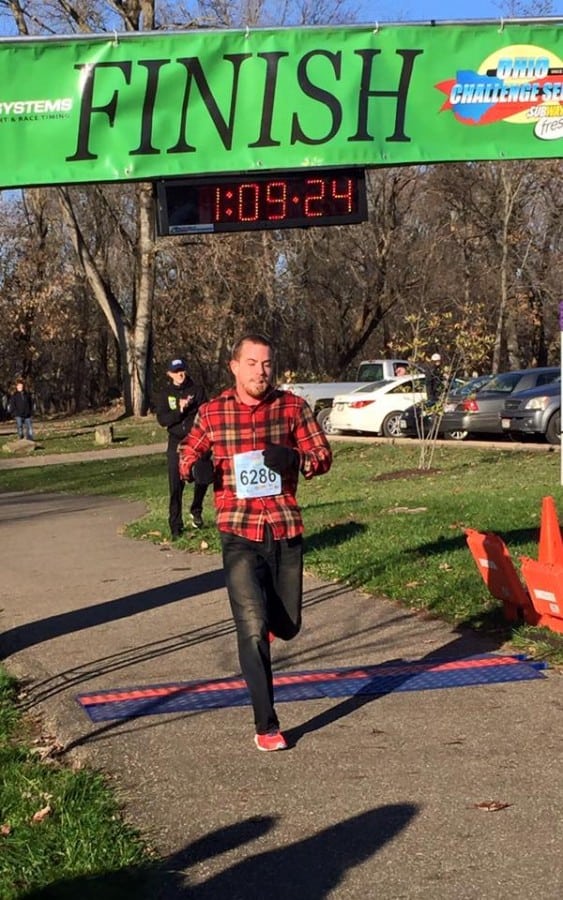
Wearing jeans and flannel and winning a half marathon.
iRunFar: Man, that’s unbelievable.
Migliozzi: We didn’t have snow yet, so I got lucky there.
iRunFar: So, you mentioned that you try to get in as much as your body allows. What has that been, in terms of marathons, each year?
Migliozzi: This year was kind of the first year I tried it. It didn’t go great. In 2014, I ran the Twin Cities Marathon in 2:18 and then two weeks later I ran the Columbus Marathon and I ran 2:20. That was a two-week period and that messed me up pretty good. In Houston, like I said, [training] went terrible but I somehow ran under 2:18. After that, I ran the Albany Marathon in Georgia a couple months later in 2:21, and I just felt miserable, it was a really bad race for me. Then two months later I ran the Pittsburgh Marathon and I ran a 2:24 there—it was a really hilly course, but I thought: Man, I need to be able to do better than this. But I really wasn’t giving my body a lot of rest. So from May all the way until October for Chicago, I said, No, I’m not doing any marathons until Chicago; I’m just going to focus on this race. That went really well, and I finally gave my body a little bit more recovery for once. [Author’s Note: Migliozzi ran a time of 2:17:44 in Chicago this year, his second-fastest marathon to date.]
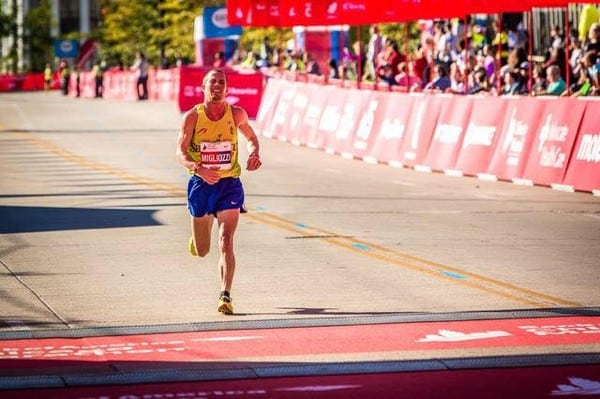
Finishing 15th at the 2015 Chicago Marathon.
iRunFar: It sounds to me like the two marathons that have gone really well, both sub-2:18s—you said in the case of Houston, training didn’t go that well, but I take it you were probably more rested. And then for Chicago, you hadn’t raced as much so you were also better rested.
Migliozzi: [pause] Yep, yeah. [laughs] I guess that’s true.
iRunFar: The trend seems to come forward in your talking there: a little bit more rest seems to treat you well.
Migliozzi: [laughs] I’ll have to keep that noted.
iRunFar: I’m willing to continue coaching you for the right price.
Migliozzi: [laughs] We’ll talk.
iRunFar: [laughs] I’m kidding, I’m kidding. So the race itself in Doha—I read the race recap that the IAU put out, and I read the brief interview that you did after the race with Flaherty. It sounds to me like you maybe stayed within yourself—to put it one way—for the first half or so, you didn’t really worry about sticking with the leaders if you weren’t feeling great. Then, when it was time to take the lead, you took the lead. That’s probably the short summary, so maybe you can expand on that—or maybe I’m wrong about how exactly that went.
Migliozzi: A few days before the race, we as a team got together at our team leader’s house, Susan Dun, and talked about what we wanted to do for the race, our goals and what not—pace-wise and team-wise and all that. Our goal as a team, we wanted to run together for 30k and we wanted to be in the lead for 30k, and try to control the race. So we wanted to get out really hard and be in the front and then control the pace all the way through 30k, and then try to start moving a little quicker.
That didn’t end up working out. A couple other guys started taking off after about 15k and me and my teammate, Tyler Andrews, covered that first initial move. We went from a 17:40 5k to a 16:40 5k, so it was definitely a big jump in pace right there. So we covered that initially, and then they once again took off. I decided that that might not be a good idea because we weren’t even halfway through the race yet. They sped up again, but I didn’t cover that. I was still maintaining that current speed that we had moved to, so I was staying at that speed with another Kenyan. We were working back and forth a little bit, but he was running—he was swerving in and out, and surging a lot. He was kind of messing up my rhythm, so I was trying not to stay focused on him. Eventually he fell off the pace and I kept maintaining that same pace still. I guess 35k to 40k, I had caught the leaders, and I think that was my fastest 5k—I think that was about a 16:40 and ended up being my fastest.
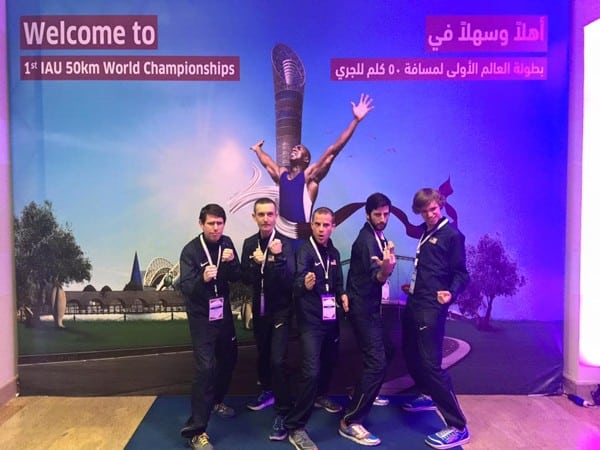
Tony with the men’s Team USA before the 2015 IAU 50k World Championships.
iRunFar: And real quickly, before you get to those last 10k, what kind of lead did they really get on you? Were those leaders 30 seconds ahead, or a whole minute up?
Migliozzi: We had someone awesome on the backstretch, I don’t know if she was affiliated with our team but she was giving me splits on how much of a lead they were gaining, or how much I was gaining back. Initially, they had 40 seconds on me, at the most. Then after maybe 30 to 35k it was only 30 seconds. So I thought, Oh, wow, I got 10 seconds right there and I didn’t speed up or anything, so they must be hurting. Yeah, so she was giving me splits on the backstretch on the lead and I saw it was dwindling and by 40k I had made it all up.
iRunFar: Amazing. So how did that last eight to 10k feel—that territory you hadn’t been to before?
Migliozzi: The pace initially—since it wasn’t so hard, I felt like I had a little bit more in the tank there at the end then I usually would, because usually I go out right at [goal] pace and try to stick it there the whole time. But we had the first nine or 10 miles be relatively comfortable. So I hadn’t spent a lot of time uncomfortable. Yeah, the last 10k I started slowing down a little bit, and I was hurting, but [the other guys] were slowing down more. I kept looking back—I wasn’t sure how big of a lead I had on them. Eventually, at about 47k, you have kind of a clear view of the course and I saw that nobody was close. I thought, Wow, I’m going to win, there’s no one within minutes of me. You know, you could kind of see the whole stretch, and I saw nobody. I was celebrating and really excited that I was going to win the inaugural 50k with ‘USA’ on my chest.
iRunFar: That had to be an incredible experience. And that was your first time representing the United States?
Migliozzi: It was the first time.
iRunFar: Very exciting. I imagine it won’t be the last.
Migliozzi: I hope not, I would love to keep representing them at races like this.
iRunFar: Absolutely. Let’s look ahead then. I know you’ll be running the Trials in, I believe, it’s February?
Migliozzi: Yeah, February 13th.
iRunFar: I imagine that will definitely be a goal race for you. I think you mentioned elsewhere that you’re aspiring to finish in the top 20?
Migliozzi: Top 20 is the initial goal, yeah. Hopefully training goes better than that and I can focus on doing even better than that. Obviously, on the other hand, hopefully it doesn’t go worse [laughs].
iRunFar: Right. I think, historically, if you run a PR you’ll be in the top 20.
Migliozzi: I think it’s pretty close. Yeah. I don’t really know how fast this new course is really, but it’s supposed to be quicker so I would think so.
iRunFar: Have you thought about your year further, for 2016?
Migliozzi: I was thinking about doing the Two Oceans Marathon, the 56k in South Africa. I talked a little bit with the race director [of Two Oceans] in Doha, and he seemed like he really wanted me to come out and do it, and he would support me and get me there and everything. But, once again, it’s something I would have to stay healthy for and what not. But I want to run as many U.S. championships as I can in 2016—that would be the main goal.
iRunFar: Some of those longer ones are earlier in the year. For example, the 50k road one is typically at [the] Caumsett [50k], which is March 5th, but that might be a tight timeline with you running the Trials. Had you thought about that one?
Migliozzi: No, but my teammate in Doha, Zach [Ornelas] is definitely doing that one. But I’m not going to do that fast of a turnover. Do you know when the World 100k would be?
iRunFar: The IAU 100k World Championships, they haven’t decided on the date or location, but it’s usually in the fall—September or October. There are a number of ways to qualify for Team USA, but the USATF 100k National Championships is usually at the Mad City 100k in Madison, Wisconsin. That’s April 9th this year. If you win that, you’re automatically on the U.S. team, so you would go to the world championships.
Migliozzi: Okay—I think that would be something I would have to end up focusing on because that’s something I would really like to do.
iRunFar: Very cool. I don’t know if you are aware of the 50-mile national championships?
Migliozzi: I am, but again I don’t know the exact date [laughs].
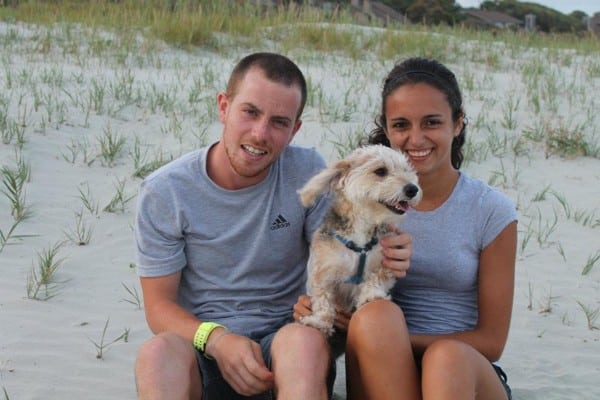
Tony and his girlfriend Sara.
iRunFar: Yeah, that’s also in the fall, typically. Well, it seems like you’re interested in going, if not already planning to go, beyond the 50k distance?
Migliozzi: Yeah, I think so. I think, honestly, the longer the race, the better I can be competitively. I would really like to see what I’m capable of in the 100k. That’s a completely different ballpark from what I’ve just done. But I think it’s about being confident and trying to figure out the nutrition plan and what not.
iRunFar: Right, if you can get that stuff figured out, I think you have the potential. Bruce Fordyce, for example, who has won the Comrades Marathon nine times down in South Africa, he was a 2:17 marathoner.
Migliozzi: Really?
iRunFar: Yeah, so when you have that marathon speed like you do—there are a number of guys, historically, who have run about 2:15 to 2:20 in the marathon and have been able to really, really crush longer-distance stuff, like ultras. Bruce Fordyce has a 50-mile PR of 4:50, which is the current world record, and he used to have the world record in the 100k—to give you an idea of what you might be capable of. I mean, not every 2:17 marathoner becomes a Bruce Fordyce, but you’ve already shown real competence at a distance beyond the marathon.
Migliozzi: [laughs] Oh man, that’s so impressive. It’s hard to put those distances into perspective.
iRunFar: [laughs] It really is, isn’t it?
Migliozzi: Yeah it is [laughs].
iRunFar: But it’s definitely fun to explore what you can do. It sounds like you have that interest. That’s awesome.
Migliozzi: Yeah, I think I’d excel at it. But I don’t know, I don’t have a lot of pure speed—I’ve never really been a guy with a lot of speed. I have really quick turnover, I’m light on my feet, so I think anything that’s longer, I’m not as hard on my body. It could go well for me.
iRunFar: Definitely, that makes sense. That skill set also transfers over to the trails really well, so I don’t know, will we see you on the trails any time soon?
Migliozzi: Anything is possible. I would consider it [laughs].
iRunFar: [laughs] Sure. But it sounds like the focus will be road races next year.
Migliozzi: Yeah, primarily road stuff.
iRunFar: Tony, thanks for being open and taking the time to chat, and best of luck at the Trials. Maybe you should train in long pants and thermal long sleeves because that seemed to work for you last time!
Migliozzi: [laughs] Yeah, definitely. Thanks so much, Eric.
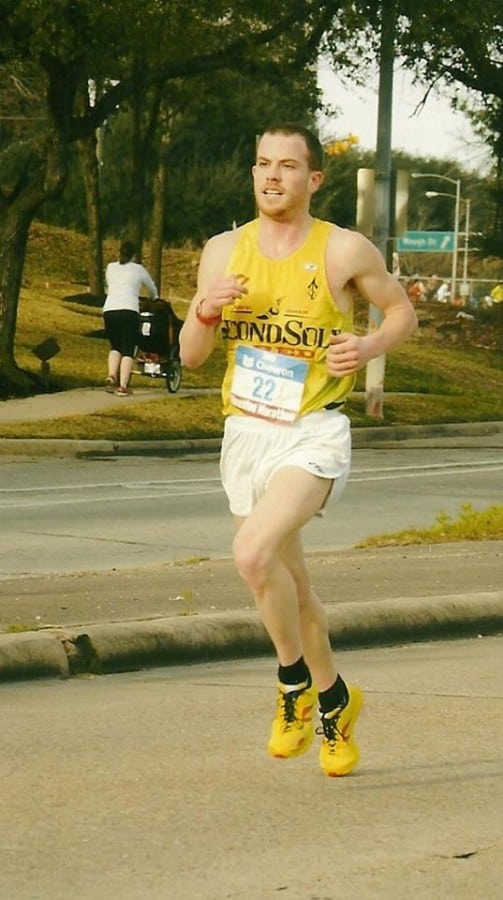
Tony setting his 2:17:27 PR at the 2015 Houston Marathon.
